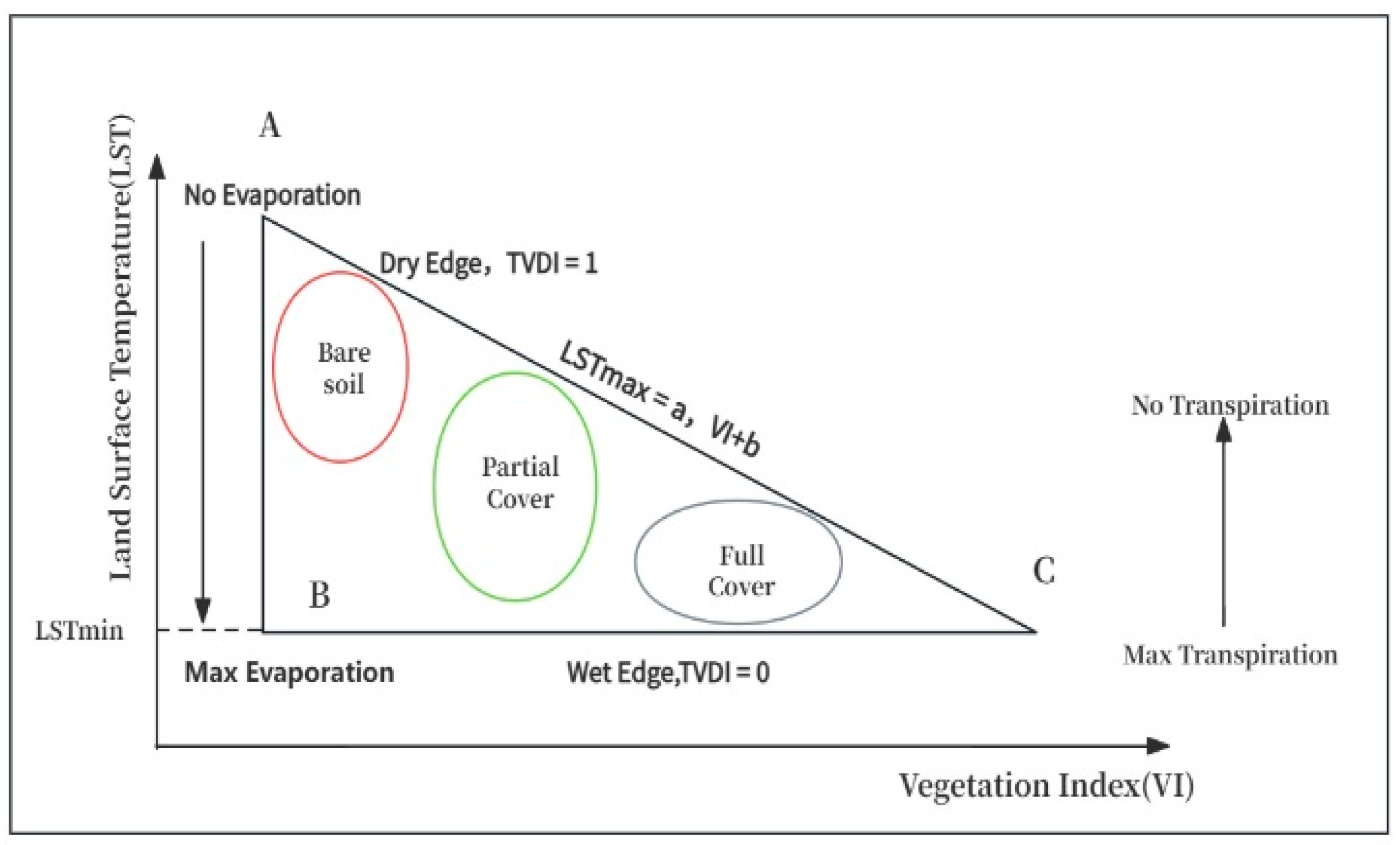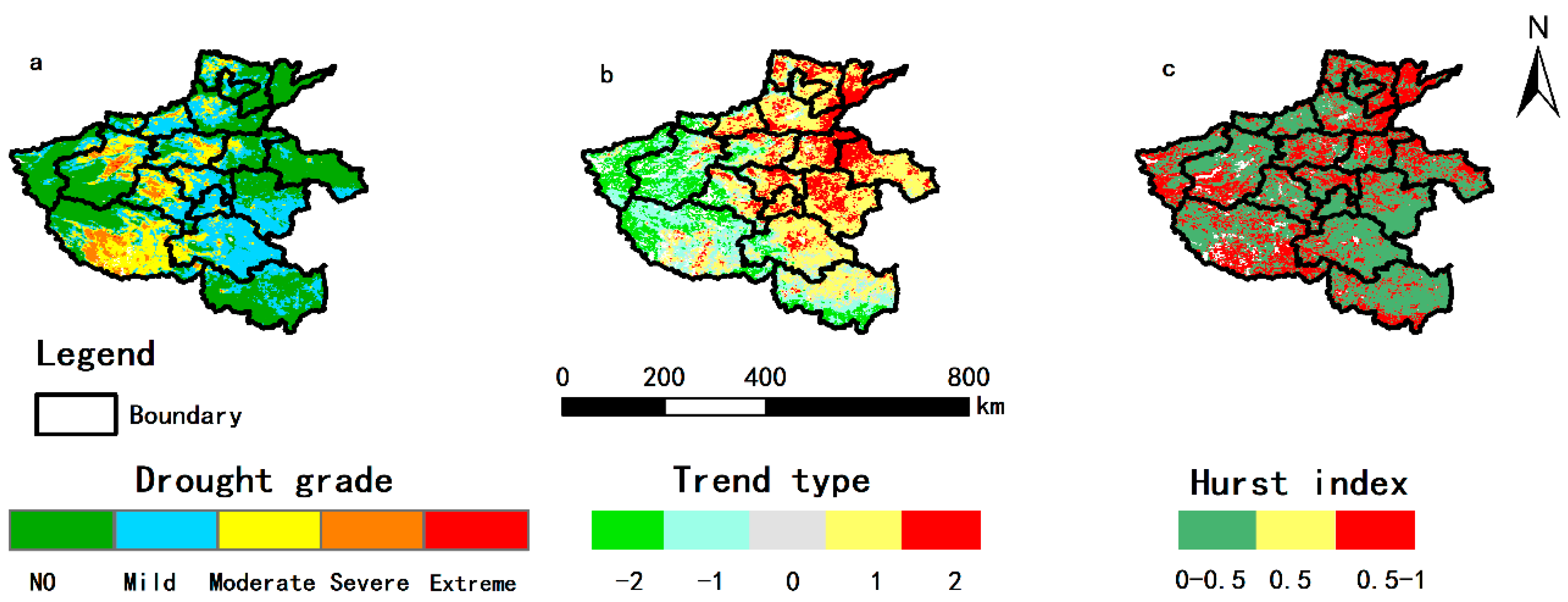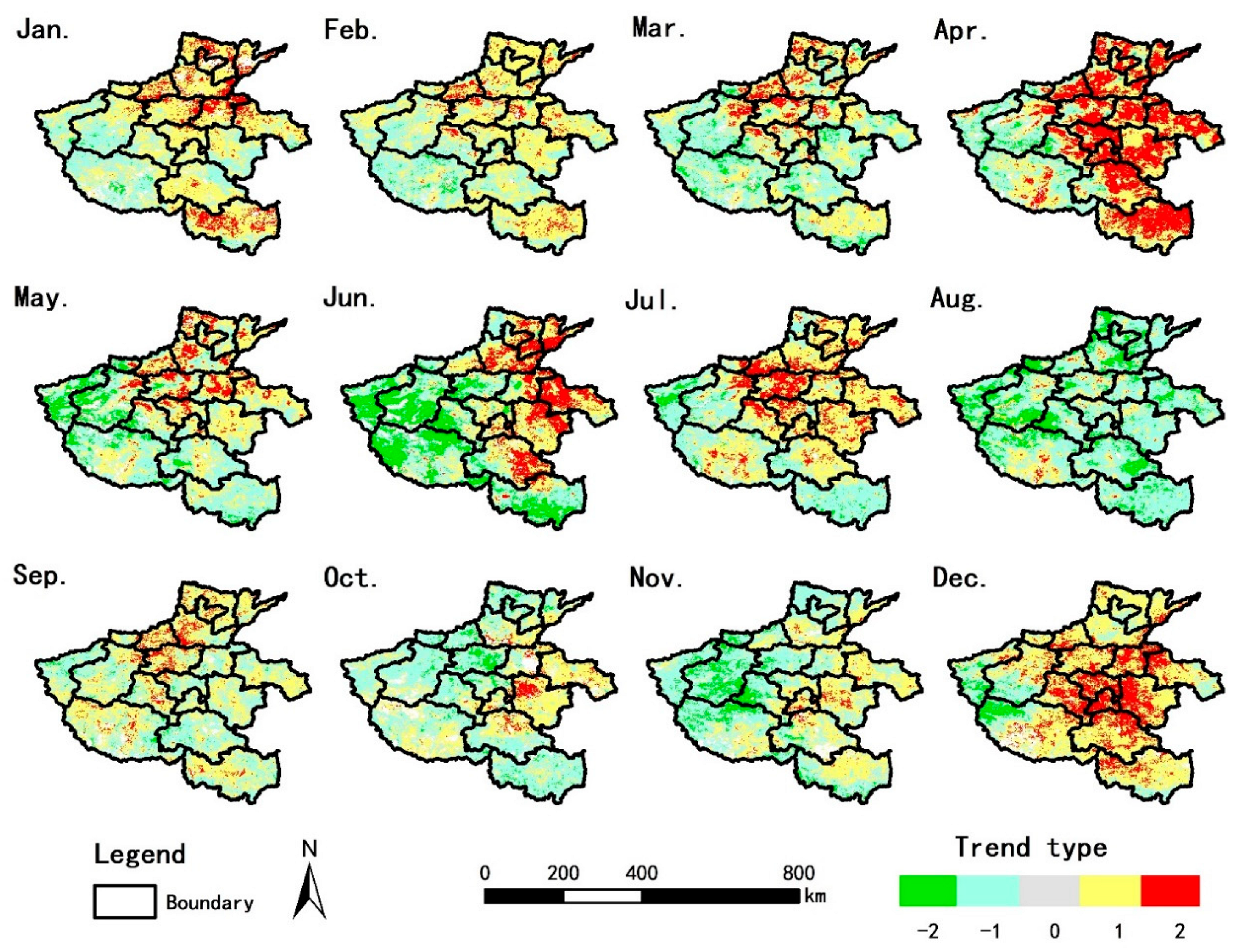Temporal and Spatial Characteristics of Agricultural Drought Based on the TVDI in Henan Province, China
Abstract
1. Introduction
2. Materials and Methods
2.1. Study Region
2.2. The Dataset
2.3. Methods
2.3.1. The Temperature Vegetation Dryness Index (TVDI)
2.3.2. Theil–Sen Median Trend Analysis and the Mann–Kendall Test
2.3.3. The Hurst Index
3. Results
3.1. Annual Change Characteristics
3.2. Quarterly Change Characteristics
3.3. Monthly Change Characteristics
4. Discussion
5. Conclusions
Author Contributions
Funding
Data Availability Statement
Conflicts of Interest
References
- Stefanos, S.; Dimitra, R.; Nikolaos, P. Drought Severity and Trends in a Mediterranean Oak Forest. Hydrology 2023, 10, 167. [Google Scholar] [CrossRef]
- Wei, W.; Liu, T.; Zhou, L.; Wang, J.P.; Yan, P.; Xie, B.B.; Zhou, J.J. Drought-Related Spatiotemporal Cumulative and Time-Lag Effects on Terrestrial Vegetation across China. Remote Sens. 2023, 15, 4362. [Google Scholar] [CrossRef]
- World Meteorological Organization (WMO). Drought Monitoring and Early Warning: Concepts, Progress and Future Challenges; WMO No.1006; World Meteorological Organization (WMO): Geneva, Switzerland, 2006. Available online: http://www.wamis.org/agm/pubs/brochures/WMO1006e.pdf (accessed on 25 October 2022).
- Geng, S.M.; Yan, D.H.; Yang, Z.Y.; Zhang, Z.B.; Yang, M.J.; Kan, G.Y. Characteristics Analysis of Summer Maize Yield Loss Caused by Drought Stress in the Northern Huaihe Plain, China. Irrig. Drain. 2018, 67, 251–268. [Google Scholar] [CrossRef]
- Shao, D.G.; Chen, S.; Tan, X.Z.; Gu, W.Q. Drought characteristics over China during 1980–2015. Int. J. Climatol. 2018, 38, 3532–3545. [Google Scholar] [CrossRef]
- Wang, P.C.; Huang, M.T.; Zhai, P.M. New progress and enlightenment on different types of drought changes from IPCC Sixth Assessment Report. Acta Meteorol. Sin. 2022, 80, 168–175. [Google Scholar]
- Mo, X.G.; Hu, S.; Lu, H.J.; Lin, Z.H.; Liu, S.X. Drought Trends over the Terrestrial China in the 21st Century in Climate Change Scenarios with Ensemble GCM Projections. J. Nat. Resour. 2018, 33, 1244–1256. [Google Scholar]
- Zhao, S.; Cong, D.; He, K.; Yang, H.; Qin, Z. Spatial-Temporal Variation of Drought in China from 1982 to 2010 Based on a modified Temperature Vegetation Drought Index (mTVDI). Sci. Rep. 2017, 7, 17473. [Google Scholar] [CrossRef]
- Wang, Q.; Liu, Y.Y.; Zhang, Y.Z.; Tong, L.J.; Li, X.Y.; Li, J.L.; Sun, Z.G. Assessment of Spatial Agglomeration of Agricultural Drought Disaster in China from 1978 to 2016. Sci. Rep. 2019, 9, 14393. [Google Scholar] [CrossRef]
- Wen, Y.L.; Zhou, L.W.; Kang, L.; Chen, H.; Guo, J.L. Drought risk analysis based on multivariate copula function in Henan Province, China. Geomat. Nat. Hazards Risk 2023, 14, 2223344. [Google Scholar] [CrossRef]
- Zhang, Q.; Zhang, J.Q.; Wang, C.Y. Risk assessment of drought disaster in typical area of corn cultivation in China. Theor. Appl. Climatol. 2017, 128, 533–540. [Google Scholar] [CrossRef]
- Zhao, H.Y.; Gao, G.; Yan, X.D.; Zhang, Q.; Hou, M.T.; Zhu, Y.Y.; Tian, Z. Risk assessment of agricultural drought using the CERES-Wheat model: A case study of Henan Plain, China. Clim. Res. 2011, 50, 247–256. [Google Scholar] [CrossRef]
- Wang, Y.Y.; Xu, C.Y.; Yu, Z.; Sun, X.L.; Li, X.M.; Wang, Y.J. Evolutionary Analysis of Drought in Henan Province Based on Temperature Vegetation Dryness Index. Geospat. Inf. 2017, 15, 98–101+11. [Google Scholar]
- Touma, D.; Ashfaq, M.; Nayak, M.A.; Kao, S.C.; Diffenbaugh, N.S. A multi-model and multi-index evaluation of drought characteristics in the 21st century. J. Hydrol. 2015, 526, 196–207. [Google Scholar] [CrossRef]
- Xu, X. China Meteorological Disasters Yearbook; China Meteorological Press: Beijing, China, 2014; p. 243. [Google Scholar]
- Su, B.; Huang, J.; Fischer, T.; Wang, Y.; Kundzewicz, Z.W.; Zhai, J.; Sun, H.; Wang, A.; Zeng, X.; Wang, G.; et al. Drought losses in China might double between the 1.5 °C and 2.0 °C warming. Proc. Natl. Acad. Sci. USA 2018, 115, 10600–10605. [Google Scholar] [CrossRef]
- Chatterjee, S.; Desai, A.R.; Zhu, J.; Townsend, P.A.; Huang, J.Y. Soil moisture as an essential component for delineating and forecasting agricultural rather than meteorological drought. Remote Sens. Environ. 2022, 269, 112833. [Google Scholar] [CrossRef]
- Krishnan, S.; Indu, J. Assessing the Potential of Temperature/Vegetation Index Space to infer Soil Moisture over Ganga Basin. J. Hydrol. 2023, 621, 129611. [Google Scholar] [CrossRef]
- Sandholt, I.; Rasmussen, K.; Andersen, J. A simple interpretation of the surface temperature/vegetation index space for assessment of surface moisture status. Remote Sens. Environ. 2002, 79, 213–224. [Google Scholar] [CrossRef]
- Liang, S.Z.; Wang, M.; Han, D.Y.; Wang, F.; Wang, G.L.; Sui, X.Y. Analysis of Relationship Between Temperature Vegetation Dryness Index and Soil Moisture at Multiple Temporal Scales and Drought Monitoring. Res. Soil Water Conserv. 2024, 31, 149–157. [Google Scholar]
- Shan, Y.; Gong, A.; Su, Y.G.; Liu, W.Y.; Li, J.; Chen, Y.H.; Jiang, W.G. Improvement of soil moisture monitoring using EVI as a key parameter based on TVDI in the north China plain. In Proceedings of the 2013 IEEE International Geoscience and Remote Sensing Symposium—IGARSS, Melbourne, Australia, 21–26 July 2013; pp. 3738–3741. [Google Scholar]
- Yu, M.; Wang, C.L. Satellite Remote Sensing Drought Monitoring Methods Based on Different Biophysical Indicators. J. Appl. Meteorol. Sci. 2011, 22, 221–231. [Google Scholar]
- Liu, H.M.; Ma, X.Q.; Sun, X.B. Research on MODIS Drought Monitoring Technology in Anhui Province. Meteorology 2010, 36, 111–115. [Google Scholar]
- Wang, S.W. Spatial and Temporal Dynamics of Drought in inner Mongolia in Recent 20 Years and its Response to Seasonal Climate and Evapotranspiration. Res. Soil Water Conserv. 2022, 29, 231–239. [Google Scholar]
- Fan, L.; Geng, B.; Wang, J.; Chen, J. Temporal and Spatial Dynamics of Drought and its Response to Climate Change in the Loess Plateau from 2001 to 2020. Res. Soil Water Conserv. 2022, 29, 183–191. [Google Scholar]
- Xia, C.H.; He, Z.H.; Liang, H.; Ren, R.Y. Spatial and Temporal Changes of Agricultural Drought in Grain Growing Season of Guizhou Province from 2006 to 2015. China Rural Water Hydropower 2021, 5, 25–30. [Google Scholar]
- Liu, L.W.; Duan, Y.H.; Xu, L.S.; Liu, Z.C.; Jiang, X. Spatiotemporal Variation Characteristics of Agricultural Drought in Shanxi Province. J. Irrig. Drain. 2020, 39, 114–121. [Google Scholar]
- Liu, X. Study on Drought Characteristics and Model Prediction in Henan Province Based on Multi-Source Heterogeneous Data. Master’s Thesis, Southwest University, Chongqing, China, 2019. [Google Scholar]
- Zhang, W.G.; Liu, H.; Yin, H.J. Monitoring of Henan Province Drought Using the Improved TVDI Index. Yellow River 2016, 38, 50–53+144. [Google Scholar]
- Yao, Y.; Chen, X.; Qian, J. Research Progress on the Application of Remote Sensing Data in Agricultural Drought Monitoring. Spectrosc. Spectr. Anal. 2019, 39, 1005–1012. [Google Scholar]
- Chen, Y.; Fan, J.Y.; Guo, F.F.; Liu, H.H. Application of Vegetation Temperature Condition Index in Drought Monitoring in Yunnan. Trans. Chin. Soc. Agric. Eng. 2011, 27, 231–236. [Google Scholar]
- Du, L.T.; Song, N.P.; Liu, K.; Hou, J.; Hu, Y.; Zhu, Y.G.; Wang, X.Y.; Wang, L.; Guo, Y.G. Comparison of Two Simulation Methods of the Temperature Vegetation Dryness Index (TVDI) for Drought Monitoring in Semi-Arid Regions of China. Remote Sens. 2017, 9, 177. [Google Scholar] [CrossRef]
- Kustas, W.P.; Norman, J.M.; Anderson, M.C.; French, A.N. Estimating subpixel surface temperatures and energy fluxes from the vegetation index-radiometric temperature relationship. Remote Sens. Environ. 2003, 85, 429–440. [Google Scholar] [CrossRef]
- Qi, S.H.; Wang, C.Y.; Niu, Z. Research on National Drought Monitoring Using Temperature Vegetation Dryness Index. J. Remote Sens. 2003, 7, 420–427. [Google Scholar]
- Wu, T.X.; Li, B.F.; Guo, H.; Wang, Y.Q.; Zhu, Y.B.; Lian, L.Z. Spatiotemporal Characteristics Analysis of Drought in the North China Plain Based on Selected Remote Sensing Drought Indices. Acta Ecol. Sin. 2023, 43, 1621–1634. [Google Scholar]
- Kang, Y.; Guo, E.L.; Wang, Y.F.; Bao, Y.L.; Bao, Y.H.; Naren, M.D. Application of Temperature Vegetation Dryness Index in Drought Monitoring on the Mongolian Plateau. Chin. J. Appl. Ecol. 2021, 32, 2534–2544. [Google Scholar]
- Deng, X.Y.; Liu, Y.; Liu, Z.H.; Yao, J.Q. Temporal-spatial dynamic change characteristics of evapotranspiration in arid region of Northwest China. Acta Ecol. Sin. 2017, 37, 2994–3008. [Google Scholar]
- Liu, X.L.; Zhou, T.G.; Wen, L.; Wu, L.; Zhang, L. Study on Drought Characteristics in Henan Province from 2000 to 2016 Based on VSWI and SPI. Arid Land Geogr. 2018, 41, 984–991. [Google Scholar]
- Lu, J.Q.; Gan, R.; Yang, F.; Zuo, Q.T. Drought Characteristics and its Correlation with Circulation Index in Henan Province Based on SPEI index. China Rural Water Hydropower 2022, 4, 17–24. [Google Scholar]
- Shang, D.Y.; Zhang, Z.H.; Yue, Y.; Hu, C.D.; Wang, Q. Drought characteristics analysis of Henan Province based on standardized precipitation index in recent 45 years. Agric. Res. Arid Areas 2021, 4, 162–170. [Google Scholar]
- Wang, B.; Shu, D.D.; Yang, F.; Duan, H. Prediction of Drought-Prone Areas in Henan Province Based on Relative Humidity Index. Water Resour. Power 2017, 35, 10–13. [Google Scholar]
- Li, X.H.; Zhang, C.; Yao, J.L. Spatial-temporal Distribution Patterns and Trend Analysis of Drought in Henan Province. J. Northwest Norm. Univ. (Nat. Sci.) 2015, 51, 85–91+104. [Google Scholar]
- Wang, F.Q.; Sun, M.Q.; Zhou, Z.H. Analysis of spatial-temporal evolution of agricultural drought based on regional agricultural drought index. Desalination Water Treat. 2018, 112, 351–356. [Google Scholar] [CrossRef]
- Wu, L.; Tian, J.F.; Jiang, Z.F. Drought evolution characteristics of Henan Province based on standardized precipitation index. J. Liaoning Tech. Univ. (Nat. Sci.) 2022, 41, 421–430. [Google Scholar]
- Chen, Z.L.; Huang, W.L.; Ye, S.L.; Qi, X.H. Analysis of differences in agricultural drought monitoring based on different TVDI indices in Fujian Province in 2018. J. Nat. Disasters 2021, 30, 233–243. [Google Scholar]
- Wang, D.Y.; Yang, Y.C.; Wang, T.; Li, Q.H. Spatiotemporal Variation of Soil Moisture and Its Influencing Factors in Henan Province Based on TVDI. China Rural. Water Hydropower 2022, 6, 138–146+153. [Google Scholar]
- Cao, M.; Chen, M.; Liu, J.; Liu, Y.L. Assessing the performance of satellite soil moisture on agricultural drought monitoring in the North China Plain. Agric. Water Manag. 2022, 263, 107450. [Google Scholar] [CrossRef]
- Cheng, X.; Xu, Y.Y.; Chen, J.L.; Liu, Q. The Impact of Climatic Conditions, Human Activities, and Catchment Characteristics on the Propagation from Meteorological to Agricultural and Hydrological Droughts in China. J. Geophys. Res. Atmos. 2023, 128, e2023JD039735. [Google Scholar] [CrossRef]
- Luo, D.; Li, L.S. Spatiotemporal evolution analysis and prediction of drought in Henan Province based on standardized precipitation evapotranspiration index. Water Supply 2023, 23, 410–427. [Google Scholar] [CrossRef]
- Houmma, I.H.; Gadal, S.; El Mansouri, L.; Garba, M.; Gbetkom, P.G.; Barkawi, M.B.M.; Hadria, R. A new multivariate agricultural drought composite index based on random forest algorithm and remote sensing data developed for Sahelian agrosystems. Geomat. Nat. Hazards Risk 2023, 14, 2223384. [Google Scholar] [CrossRef]









| Level | TVDI | Drought Grade | Level | TVDI | Drought Grade |
|---|---|---|---|---|---|
| 1 | (0 ≤ TVDI < 0.6) | No Drought | 4 | (0.8 ≤ TVDI < 0.9) | Severe Drought |
| 2 | (0.6 ≤ TVDI < 0.7) | Mild Drought | 5 | (0.9 ≤ TVD ≤ 1.0) | Extreme Drought |
| 3 | (0.7 ≤ TVDI < 0.8) | Moderate Drought |
| Item | Meaning of Numbers | Item | Meaning of Numbers |
|---|---|---|---|
| −2 | Significant decline | 1 | Slight increase |
| −1 | Slight decline | 2 | Significant increase |
| 0 | No change |
| Tendency | Percent (%) | Tendency | Percent (%) | Hurst | Percent (%) |
|---|---|---|---|---|---|
| Significant decline | 12.42 | Slight increase | 32.48 | 0–0.5 | 64.96 |
| light decline | 31.16 | Significant increase | 17.55 | 0.5 | 0.01 |
| No change | 6.39 | - | - | 0.5–1 | 35.03 |
| Tendency | Percent (%) | |||
|---|---|---|---|---|
| Spring | Summer | Autumn | Winter | |
| Significant decline | 12.42 | 3.47 | 17.44 | 2.25 |
| Slight decline | 31.16 | 22.88 | 37.14 | 17.44 |
| No change | 6.39 | 5.38 | 6.70 | 5.56 |
| Slight increase | 32.48 | 40.15 | 32.24 | 54.21 |
| Significant increase | 17.55 | 28.12 | 6.48 | 20.54 |
| Hurst | Spring | Summer | Autumn | Winder |
| 0–0.5 | 81.78 | 80.68 | 79.23 | 83.63 |
| 0.5 | 0 | 0.01 | 0 | 0.53 |
| 0.5–1.0 | 18.22 | 19.31 | 20.77 | 15.83 |
| Month | Mean | Drought Grade | Max | Drought Grade | Month | Mean | Drought Grade | Max | Drought Grade |
|---|---|---|---|---|---|---|---|---|---|
| January | 0.615 | Mild | 0.896 | Severe | July | 0.507 | No | 0.849 | Severe |
| February | 0.611 | Mild | 0.871 | Severe | August | 0.544 | No | 0.921 | Extreme |
| March | 0.567 | No | 0.877 | Severe | September | 0.621 | Mild | 0.897 | Severe |
| April | 0.559 | No | 0.940 | Extreme | October | 0.637 | Mild | 0.874 | Severe |
| May | 0.541 | No | 0.895 | Severe | November | 0.606 | Mild | 0.871 | Severe |
| June | 0.556 | No | 0.895 | Severe | December | 0.607 | Mild | 0.915 | Extreme |
| Tendency | Percent (%) | |||||||||||
|---|---|---|---|---|---|---|---|---|---|---|---|---|
| January | February | March | April | May | June | July | August | September | October | November | December | |
| Significant decline | 0.99 | 1.02 | 6.57 | 3.12 | 10.60 | 23.20 | 2.38 | 22.77 | 1.77 | 4.43 | 10.74 | 3.72 |
| Slight decline | 25.98 | 29.14 | 43.25 | 21.56 | 38.78 | 33.47 | 33.47 | 62.38 | 34.97 | 49.17 | 45.13 | 14.12 |
| No change | 7.74 | 8.65 | 7.65 | 4.38 | 6.83 | 6.12 | 6.12 | 3.59 | 9.88 | 8.07 | 6.84 | 4.84 |
| Slight increase | 52.90 | 57.08 | 35.36 | 36.08 | 36.20 | 46.02 | 16.02 | 10.48 | 48.12 | 35.09 | 35.30 | 55.11 |
| Significant increase | 12.40 | 4.11 | 7.17 | 34.86 | 7.58 | 12.02 | 12.02 | 0.78 | 5.27 | 3.25 | 2.01 | 22.21 |
| Hurst | Percent(%) | |||||||||||
| 0–0.5 | 92.03 | 84.57 | 83.59 | 78.54 | 77.07 | 67.30 | 85.48 | 85.12 | 71.18 | 83.28 | 83.28 | 81.96 |
| 0.5 | 0 | 0 | 0.01 | 0 | 0 | 0 | 0 | 0.01 | 0.01 | 0 | 0.01 | 0 |
| 0.5–1 | 7.97 | 15.43 | 16.40 | 21.46 | 22.93 | 32.70 | 14.52 | 14.87 | 28.81 | 16.72 | 16.71 | 18.04 |
Disclaimer/Publisher’s Note: The statements, opinions and data contained in all publications are solely those of the individual author(s) and contributor(s) and not of MDPI and/or the editor(s). MDPI and/or the editor(s) disclaim responsibility for any injury to people or property resulting from any ideas, methods, instructions or products referred to in the content. |
© 2024 by the authors. Licensee MDPI, Basel, Switzerland. This article is an open access article distributed under the terms and conditions of the Creative Commons Attribution (CC BY) license (https://creativecommons.org/licenses/by/4.0/).
Share and Cite
Li, Y.; Wang, X.; Wang, F.; Feng, K.; Li, H.; Han, Y.; Chen, S. Temporal and Spatial Characteristics of Agricultural Drought Based on the TVDI in Henan Province, China. Water 2024, 16, 1010. https://doi.org/10.3390/w16071010
Li Y, Wang X, Wang F, Feng K, Li H, Han Y, Chen S. Temporal and Spatial Characteristics of Agricultural Drought Based on the TVDI in Henan Province, China. Water. 2024; 16(7):1010. https://doi.org/10.3390/w16071010
Chicago/Turabian StyleLi, Yanbin, Xin Wang, Fei Wang, Kai Feng, Hongxing Li, Yuhang Han, and Shaodan Chen. 2024. "Temporal and Spatial Characteristics of Agricultural Drought Based on the TVDI in Henan Province, China" Water 16, no. 7: 1010. https://doi.org/10.3390/w16071010
APA StyleLi, Y., Wang, X., Wang, F., Feng, K., Li, H., Han, Y., & Chen, S. (2024). Temporal and Spatial Characteristics of Agricultural Drought Based on the TVDI in Henan Province, China. Water, 16(7), 1010. https://doi.org/10.3390/w16071010







